Business Continuity and Disaster Recovery: Cloud Incident Challenges
VerifiedAdded on 2020/04/15
|6
|874
|367
Report
AI Summary
This report examines the challenges incident handlers face when organizations move resources to the cloud. It highlights issues such as legal and regulatory complexities, the breakdown of perimeter security, data loss, account and service hijacking, and threats from malicious insiders. The report emphasizes the importance of incident handlers understanding cloud data transmission and management, the security of cloud vendors' internal structures, and the need to consider customer data and assets. It also discusses the necessity of disaster recovery planning and the challenges of applying encryption schemes. The conclusion emphasizes the need for incident handlers to assess and address these challenges proactively.
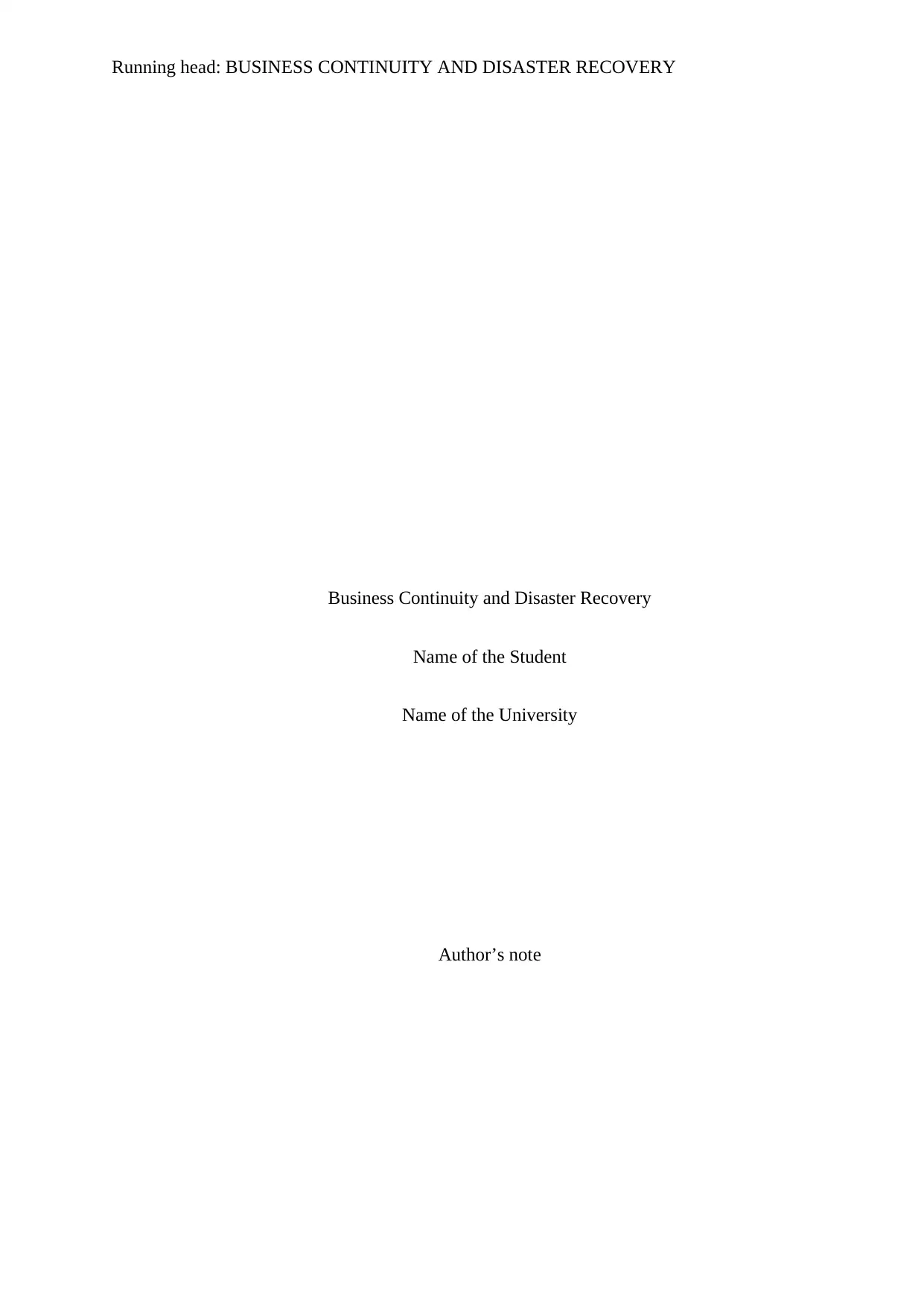
Running head: BUSINESS CONTINUITY AND DISASTER RECOVERY
Business Continuity and Disaster Recovery
Name of the Student
Name of the University
Author’s note
Business Continuity and Disaster Recovery
Name of the Student
Name of the University
Author’s note
Paraphrase This Document
Need a fresh take? Get an instant paraphrase of this document with our AI Paraphraser
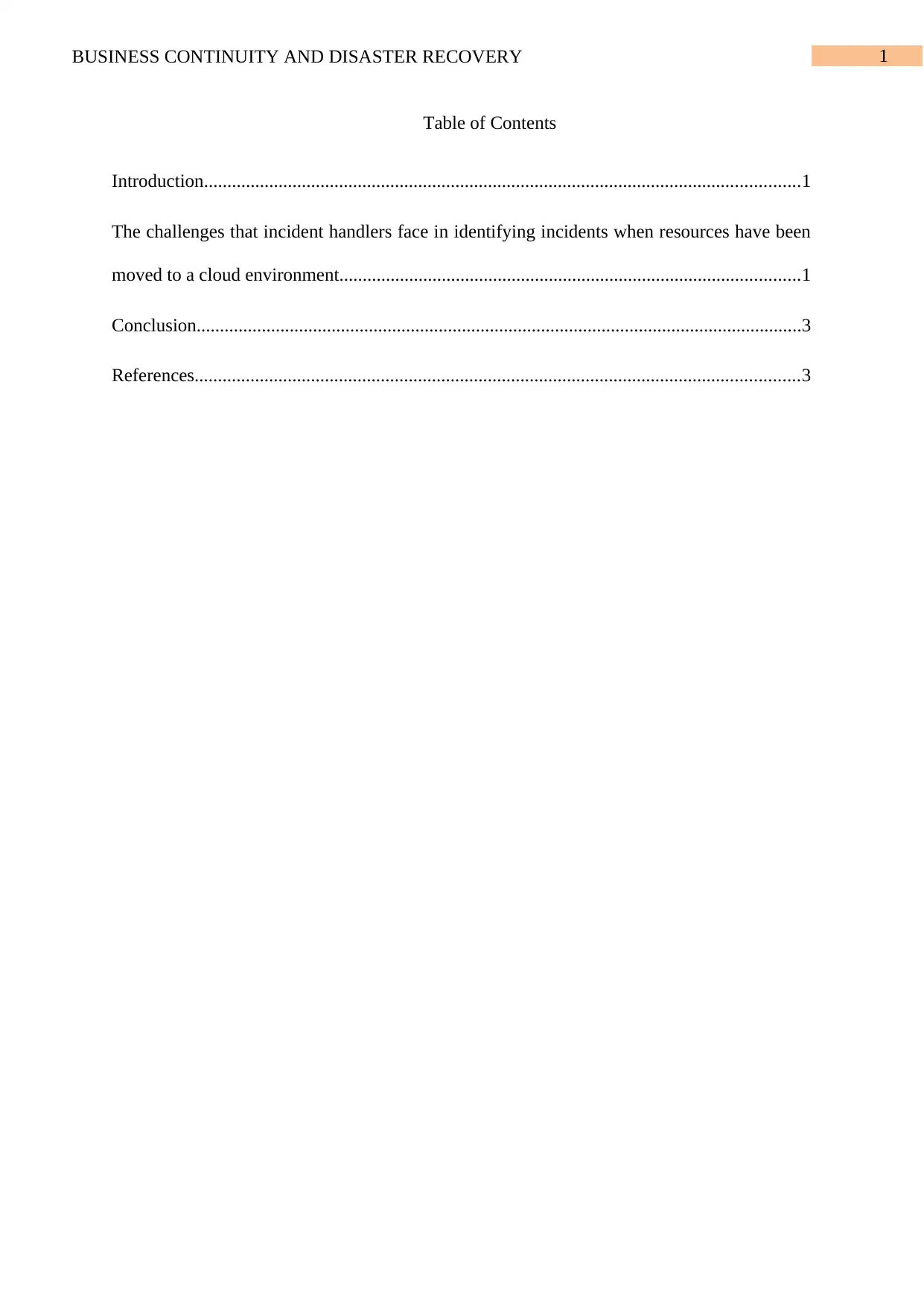
1BUSINESS CONTINUITY AND DISASTER RECOVERY
Table of Contents
Introduction................................................................................................................................1
The challenges that incident handlers face in identifying incidents when resources have been
moved to a cloud environment...................................................................................................1
Conclusion..................................................................................................................................3
References..................................................................................................................................3
Table of Contents
Introduction................................................................................................................................1
The challenges that incident handlers face in identifying incidents when resources have been
moved to a cloud environment...................................................................................................1
Conclusion..................................................................................................................................3
References..................................................................................................................................3
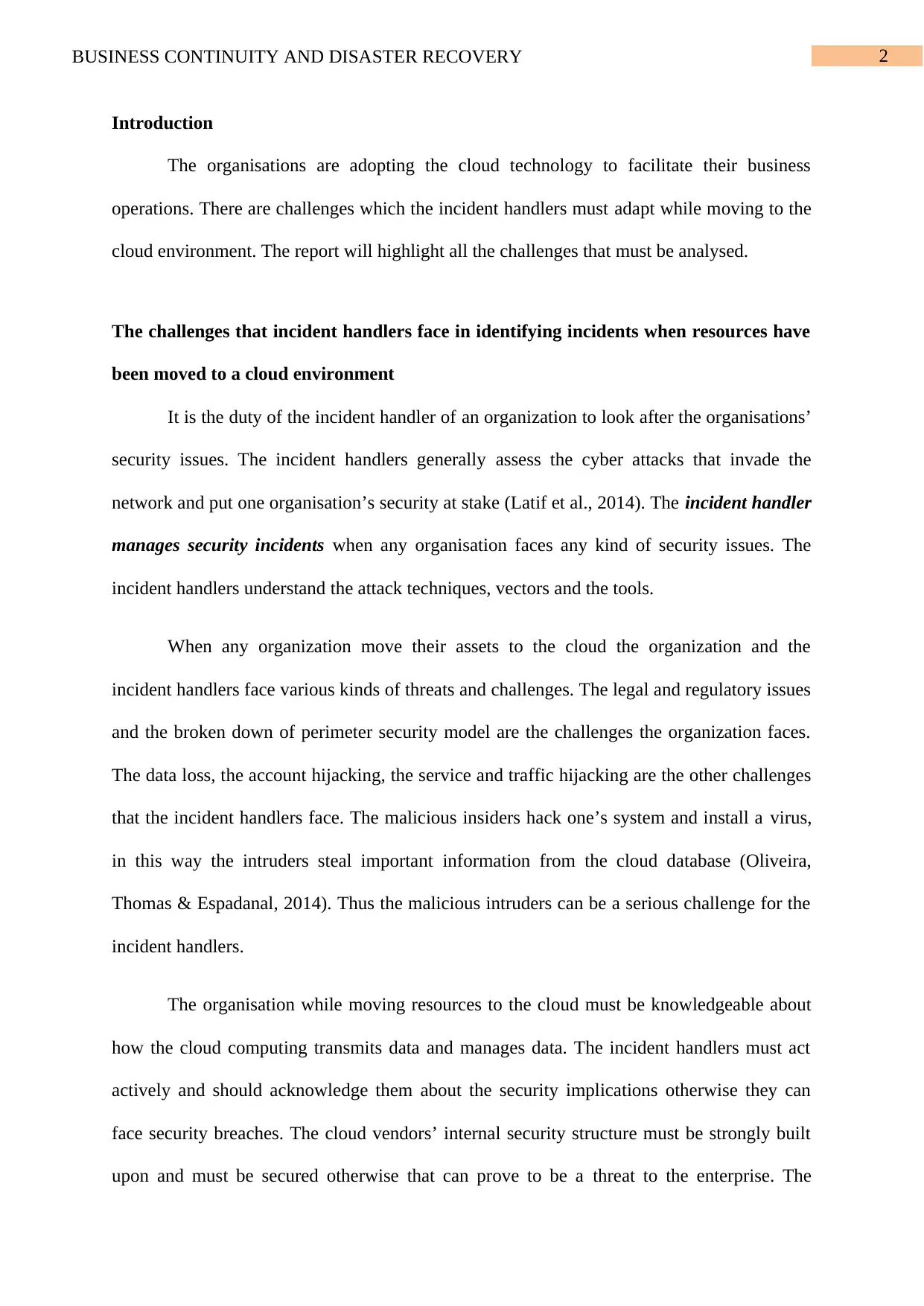
2BUSINESS CONTINUITY AND DISASTER RECOVERY
Introduction
The organisations are adopting the cloud technology to facilitate their business
operations. There are challenges which the incident handlers must adapt while moving to the
cloud environment. The report will highlight all the challenges that must be analysed.
The challenges that incident handlers face in identifying incidents when resources have
been moved to a cloud environment
It is the duty of the incident handler of an organization to look after the organisations’
security issues. The incident handlers generally assess the cyber attacks that invade the
network and put one organisation’s security at stake (Latif et al., 2014). The incident handler
manages security incidents when any organisation faces any kind of security issues. The
incident handlers understand the attack techniques, vectors and the tools.
When any organization move their assets to the cloud the organization and the
incident handlers face various kinds of threats and challenges. The legal and regulatory issues
and the broken down of perimeter security model are the challenges the organization faces.
The data loss, the account hijacking, the service and traffic hijacking are the other challenges
that the incident handlers face. The malicious insiders hack one’s system and install a virus,
in this way the intruders steal important information from the cloud database (Oliveira,
Thomas & Espadanal, 2014). Thus the malicious intruders can be a serious challenge for the
incident handlers.
The organisation while moving resources to the cloud must be knowledgeable about
how the cloud computing transmits data and manages data. The incident handlers must act
actively and should acknowledge them about the security implications otherwise they can
face security breaches. The cloud vendors’ internal security structure must be strongly built
upon and must be secured otherwise that can prove to be a threat to the enterprise. The
Introduction
The organisations are adopting the cloud technology to facilitate their business
operations. There are challenges which the incident handlers must adapt while moving to the
cloud environment. The report will highlight all the challenges that must be analysed.
The challenges that incident handlers face in identifying incidents when resources have
been moved to a cloud environment
It is the duty of the incident handler of an organization to look after the organisations’
security issues. The incident handlers generally assess the cyber attacks that invade the
network and put one organisation’s security at stake (Latif et al., 2014). The incident handler
manages security incidents when any organisation faces any kind of security issues. The
incident handlers understand the attack techniques, vectors and the tools.
When any organization move their assets to the cloud the organization and the
incident handlers face various kinds of threats and challenges. The legal and regulatory issues
and the broken down of perimeter security model are the challenges the organization faces.
The data loss, the account hijacking, the service and traffic hijacking are the other challenges
that the incident handlers face. The malicious insiders hack one’s system and install a virus,
in this way the intruders steal important information from the cloud database (Oliveira,
Thomas & Espadanal, 2014). Thus the malicious intruders can be a serious challenge for the
incident handlers.
The organisation while moving resources to the cloud must be knowledgeable about
how the cloud computing transmits data and manages data. The incident handlers must act
actively and should acknowledge them about the security implications otherwise they can
face security breaches. The cloud vendors’ internal security structure must be strongly built
upon and must be secured otherwise that can prove to be a threat to the enterprise. The
⊘ This is a preview!⊘
Do you want full access?
Subscribe today to unlock all pages.

Trusted by 1+ million students worldwide
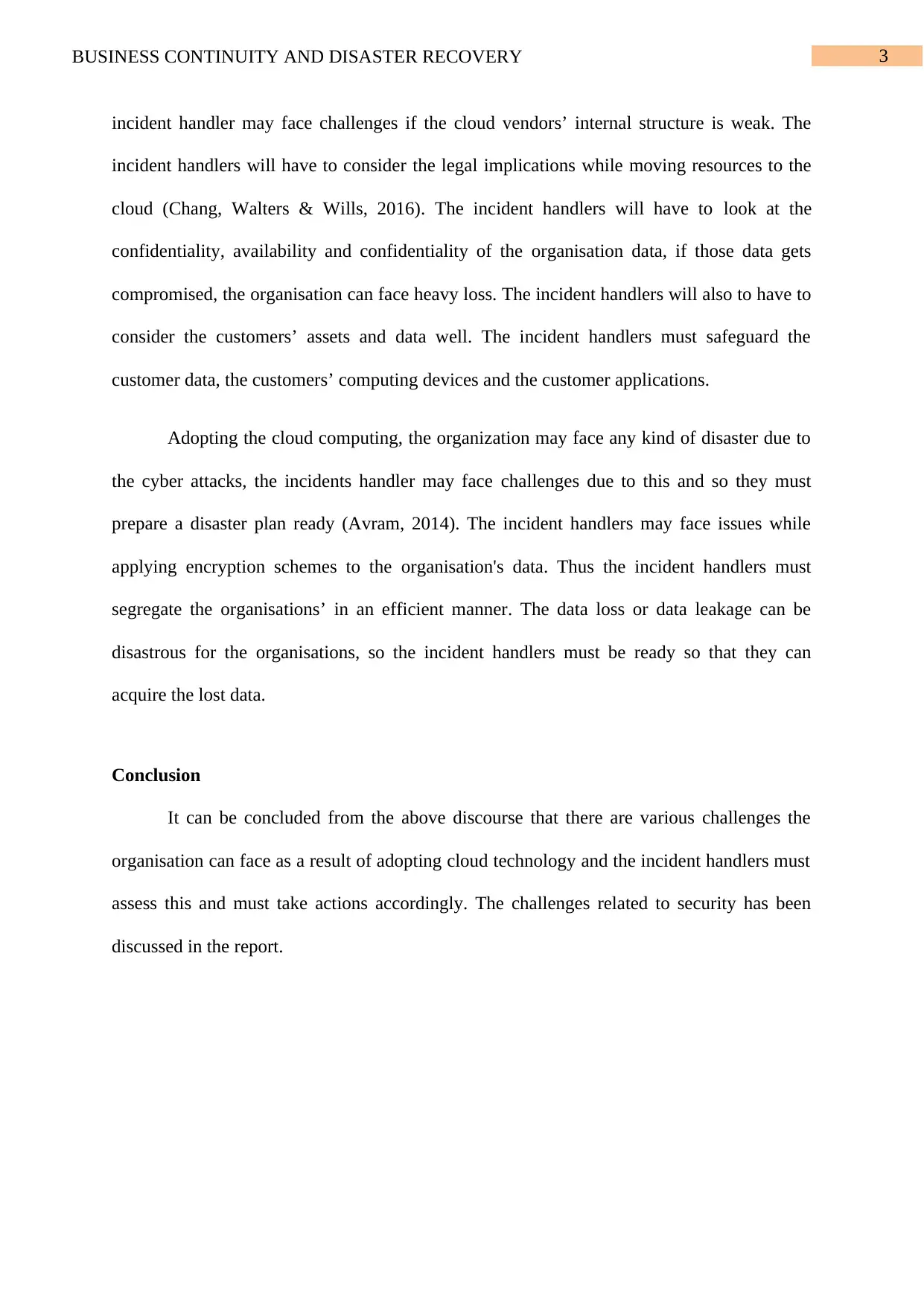
3BUSINESS CONTINUITY AND DISASTER RECOVERY
incident handler may face challenges if the cloud vendors’ internal structure is weak. The
incident handlers will have to consider the legal implications while moving resources to the
cloud (Chang, Walters & Wills, 2016). The incident handlers will have to look at the
confidentiality, availability and confidentiality of the organisation data, if those data gets
compromised, the organisation can face heavy loss. The incident handlers will also to have to
consider the customers’ assets and data well. The incident handlers must safeguard the
customer data, the customers’ computing devices and the customer applications.
Adopting the cloud computing, the organization may face any kind of disaster due to
the cyber attacks, the incidents handler may face challenges due to this and so they must
prepare a disaster plan ready (Avram, 2014). The incident handlers may face issues while
applying encryption schemes to the organisation's data. Thus the incident handlers must
segregate the organisations’ in an efficient manner. The data loss or data leakage can be
disastrous for the organisations, so the incident handlers must be ready so that they can
acquire the lost data.
Conclusion
It can be concluded from the above discourse that there are various challenges the
organisation can face as a result of adopting cloud technology and the incident handlers must
assess this and must take actions accordingly. The challenges related to security has been
discussed in the report.
incident handler may face challenges if the cloud vendors’ internal structure is weak. The
incident handlers will have to consider the legal implications while moving resources to the
cloud (Chang, Walters & Wills, 2016). The incident handlers will have to look at the
confidentiality, availability and confidentiality of the organisation data, if those data gets
compromised, the organisation can face heavy loss. The incident handlers will also to have to
consider the customers’ assets and data well. The incident handlers must safeguard the
customer data, the customers’ computing devices and the customer applications.
Adopting the cloud computing, the organization may face any kind of disaster due to
the cyber attacks, the incidents handler may face challenges due to this and so they must
prepare a disaster plan ready (Avram, 2014). The incident handlers may face issues while
applying encryption schemes to the organisation's data. Thus the incident handlers must
segregate the organisations’ in an efficient manner. The data loss or data leakage can be
disastrous for the organisations, so the incident handlers must be ready so that they can
acquire the lost data.
Conclusion
It can be concluded from the above discourse that there are various challenges the
organisation can face as a result of adopting cloud technology and the incident handlers must
assess this and must take actions accordingly. The challenges related to security has been
discussed in the report.
Paraphrase This Document
Need a fresh take? Get an instant paraphrase of this document with our AI Paraphraser
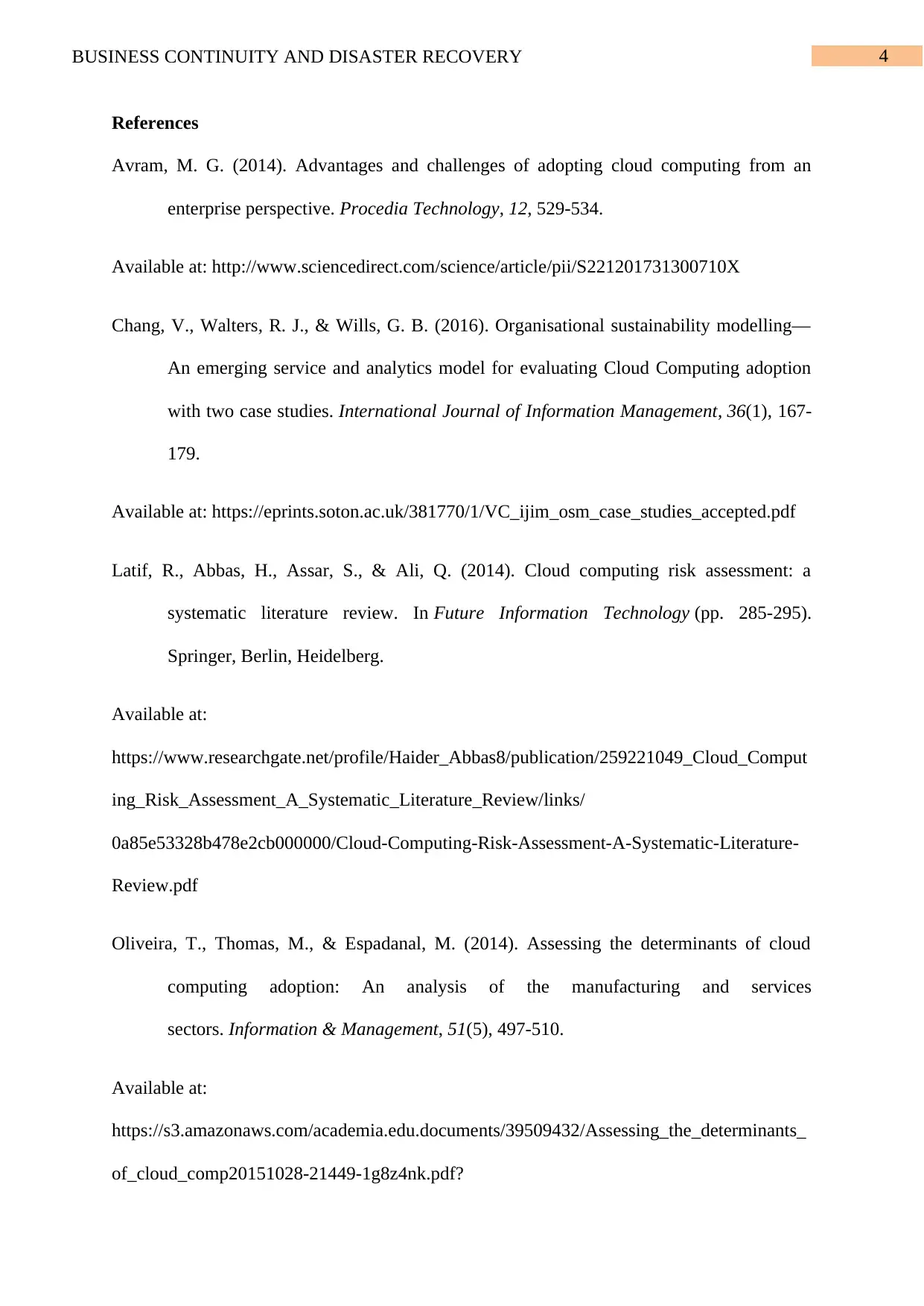
4BUSINESS CONTINUITY AND DISASTER RECOVERY
References
Avram, M. G. (2014). Advantages and challenges of adopting cloud computing from an
enterprise perspective. Procedia Technology, 12, 529-534.
Available at: http://www.sciencedirect.com/science/article/pii/S221201731300710X
Chang, V., Walters, R. J., & Wills, G. B. (2016). Organisational sustainability modelling—
An emerging service and analytics model for evaluating Cloud Computing adoption
with two case studies. International Journal of Information Management, 36(1), 167-
179.
Available at: https://eprints.soton.ac.uk/381770/1/VC_ijim_osm_case_studies_accepted.pdf
Latif, R., Abbas, H., Assar, S., & Ali, Q. (2014). Cloud computing risk assessment: a
systematic literature review. In Future Information Technology (pp. 285-295).
Springer, Berlin, Heidelberg.
Available at:
https://www.researchgate.net/profile/Haider_Abbas8/publication/259221049_Cloud_Comput
ing_Risk_Assessment_A_Systematic_Literature_Review/links/
0a85e53328b478e2cb000000/Cloud-Computing-Risk-Assessment-A-Systematic-Literature-
Review.pdf
Oliveira, T., Thomas, M., & Espadanal, M. (2014). Assessing the determinants of cloud
computing adoption: An analysis of the manufacturing and services
sectors. Information & Management, 51(5), 497-510.
Available at:
https://s3.amazonaws.com/academia.edu.documents/39509432/Assessing_the_determinants_
of_cloud_comp20151028-21449-1g8z4nk.pdf?
References
Avram, M. G. (2014). Advantages and challenges of adopting cloud computing from an
enterprise perspective. Procedia Technology, 12, 529-534.
Available at: http://www.sciencedirect.com/science/article/pii/S221201731300710X
Chang, V., Walters, R. J., & Wills, G. B. (2016). Organisational sustainability modelling—
An emerging service and analytics model for evaluating Cloud Computing adoption
with two case studies. International Journal of Information Management, 36(1), 167-
179.
Available at: https://eprints.soton.ac.uk/381770/1/VC_ijim_osm_case_studies_accepted.pdf
Latif, R., Abbas, H., Assar, S., & Ali, Q. (2014). Cloud computing risk assessment: a
systematic literature review. In Future Information Technology (pp. 285-295).
Springer, Berlin, Heidelberg.
Available at:
https://www.researchgate.net/profile/Haider_Abbas8/publication/259221049_Cloud_Comput
ing_Risk_Assessment_A_Systematic_Literature_Review/links/
0a85e53328b478e2cb000000/Cloud-Computing-Risk-Assessment-A-Systematic-Literature-
Review.pdf
Oliveira, T., Thomas, M., & Espadanal, M. (2014). Assessing the determinants of cloud
computing adoption: An analysis of the manufacturing and services
sectors. Information & Management, 51(5), 497-510.
Available at:
https://s3.amazonaws.com/academia.edu.documents/39509432/Assessing_the_determinants_
of_cloud_comp20151028-21449-1g8z4nk.pdf?

5BUSINESS CONTINUITY AND DISASTER RECOVERY
AWSAccessKeyId=AKIAIWOWYYGZ2Y53UL3A&Expires=1510987437&Signature=sTg
2alzdRr%2B39R3i016ab%2F3fYBM%3D&response-content-disposition=inline%3B
%20filename%3DAssessing_the_determinants_of_cloud_comp.pdf
AWSAccessKeyId=AKIAIWOWYYGZ2Y53UL3A&Expires=1510987437&Signature=sTg
2alzdRr%2B39R3i016ab%2F3fYBM%3D&response-content-disposition=inline%3B
%20filename%3DAssessing_the_determinants_of_cloud_comp.pdf
⊘ This is a preview!⊘
Do you want full access?
Subscribe today to unlock all pages.

Trusted by 1+ million students worldwide
1 out of 6
Related Documents
Your All-in-One AI-Powered Toolkit for Academic Success.
+13062052269
info@desklib.com
Available 24*7 on WhatsApp / Email
![[object Object]](/_next/static/media/star-bottom.7253800d.svg)
Unlock your academic potential
Copyright © 2020–2025 A2Z Services. All Rights Reserved. Developed and managed by ZUCOL.




